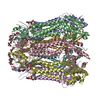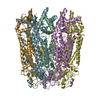[English] 日本語
 Yorodumi
Yorodumi- PDB-8gts: CryoEM structure of human Pannexin1 with R217H congenital mutation. -
+ Open data
Open data
- Basic information
Basic information
| Entry | Database: PDB / ID: 8gts | ||||||
|---|---|---|---|---|---|---|---|
| Title | CryoEM structure of human Pannexin1 with R217H congenital mutation. | ||||||
 Components Components | Pannexin-1 | ||||||
 Keywords Keywords | MEMBRANE PROTEIN / Pannexin1 / ATP release / large-pore ion channel | ||||||
| Function / homology |  Function and homology information Function and homology informationATP transmembrane transporter activity / ATP transport / Electric Transmission Across Gap Junctions / leak channel activity / positive regulation of interleukin-1 alpha production / wide pore channel activity / bleb / monoatomic anion transmembrane transport / monoatomic anion channel activity / gap junction ...ATP transmembrane transporter activity / ATP transport / Electric Transmission Across Gap Junctions / leak channel activity / positive regulation of interleukin-1 alpha production / wide pore channel activity / bleb / monoatomic anion transmembrane transport / monoatomic anion channel activity / gap junction / gap junction channel activity / positive regulation of macrophage cytokine production / Mechanical load activates signaling by PIEZO1 and integrins in osteocytes / oogenesis / response to ATP / The NLRP3 inflammasome / monoatomic cation transport / response to ischemia / positive regulation of interleukin-1 beta production / calcium channel activity / actin filament binding / calcium ion transport / cell-cell signaling / protease binding / scaffold protein binding / High laminar flow shear stress activates signaling by PIEZO1 and PECAM1:CDH5:KDR in endothelial cells / transmembrane transporter binding / signaling receptor binding / endoplasmic reticulum membrane / structural molecule activity / endoplasmic reticulum / protein-containing complex / identical protein binding / membrane / plasma membrane Similarity search - Function | ||||||
| Biological species |  Homo sapiens (human) Homo sapiens (human) | ||||||
| Method | ELECTRON MICROSCOPY / single particle reconstruction / cryo EM / Resolution: 3.87 Å | ||||||
 Authors Authors | Hussain, N. / Penmatsa, A. | ||||||
| Funding support |  India, 1items India, 1items
| ||||||
 Citation Citation |  Journal: Nat Commun / Year: 2024 Journal: Nat Commun / Year: 2024Title: Cryo-EM structures of pannexin 1 and 3 reveal differences among pannexin isoforms. Authors: Nazia Hussain / Ashish Apotikar / Shabareesh Pidathala / Sourajit Mukherjee / Ananth Prasad Burada / Sujit Kumar Sikdar / Kutti R Vinothkumar / Aravind Penmatsa /   Abstract: Pannexins are single-membrane large-pore channels that release ions and ATP upon activation. Three isoforms of pannexins 1, 2, and 3, perform diverse cellular roles and differ in their pore lining ...Pannexins are single-membrane large-pore channels that release ions and ATP upon activation. Three isoforms of pannexins 1, 2, and 3, perform diverse cellular roles and differ in their pore lining residues. In this study, we report the cryo-EM structure of pannexin 3 at 3.9 Å and analyze its structural differences with pannexin isoforms 1 and 2. The pannexin 3 vestibule has two distinct chambers and a wider pore radius in comparison to pannexins 1 and 2. We further report two cryo-EM structures of pannexin 1, with pore substitutions W74R/R75D that mimic the pore lining residues of pannexin 2 and a germline mutant of pannexin 1, R217H at resolutions of 3.2 Å and 3.9 Å, respectively. Substitution of cationic residues in the vestibule of pannexin 1 results in reduced ATP interaction propensities to the channel. The germline mutant R217H in transmembrane helix 3 (TM3), leads to a partially constricted pore, reduced ATP interaction and weakened voltage sensitivity. The study compares the three pannexin isoform structures, the effects of substitutions of pore and vestibule-lining residues and allosteric effects of a pathological substitution on channel structure and function thereby enhancing our understanding of this vital group of ATP-release channels. | ||||||
| History |
|
- Structure visualization
Structure visualization
| Structure viewer | Molecule:  Molmil Molmil Jmol/JSmol Jmol/JSmol |
|---|
- Downloads & links
Downloads & links
- Download
Download
| PDBx/mmCIF format |  8gts.cif.gz 8gts.cif.gz | 351.5 KB | Display |  PDBx/mmCIF format PDBx/mmCIF format |
|---|---|---|---|---|
| PDB format |  pdb8gts.ent.gz pdb8gts.ent.gz | 283.5 KB | Display |  PDB format PDB format |
| PDBx/mmJSON format |  8gts.json.gz 8gts.json.gz | Tree view |  PDBx/mmJSON format PDBx/mmJSON format | |
| Others |  Other downloads Other downloads |
-Validation report
| Summary document |  8gts_validation.pdf.gz 8gts_validation.pdf.gz | 1.5 MB | Display |  wwPDB validaton report wwPDB validaton report |
|---|---|---|---|---|
| Full document |  8gts_full_validation.pdf.gz 8gts_full_validation.pdf.gz | 1.5 MB | Display | |
| Data in XML |  8gts_validation.xml.gz 8gts_validation.xml.gz | 67.8 KB | Display | |
| Data in CIF |  8gts_validation.cif.gz 8gts_validation.cif.gz | 93.5 KB | Display | |
| Arichive directory |  https://data.pdbj.org/pub/pdb/validation_reports/gt/8gts https://data.pdbj.org/pub/pdb/validation_reports/gt/8gts ftp://data.pdbj.org/pub/pdb/validation_reports/gt/8gts ftp://data.pdbj.org/pub/pdb/validation_reports/gt/8gts | HTTPS FTP |
-Related structure data
| Related structure data |  34266MC  8gtrC  8gttC M: map data used to model this data C: citing same article ( |
|---|---|
| Similar structure data | Similarity search - Function & homology  F&H Search F&H Search |
- Links
Links
- Assembly
Assembly
| Deposited unit | 
|
|---|---|
| 1 |
|
- Components
Components
| #1: Protein | Mass: 48074.816 Da / Num. of mol.: 7 / Mutation: R217H Source method: isolated from a genetically manipulated source Source: (gene. exp.)  Homo sapiens (human) / Gene: PANX1, MRS1, UNQ2529/PRO6028 / Cell line (production host): HEK293S / Production host: Homo sapiens (human) / Gene: PANX1, MRS1, UNQ2529/PRO6028 / Cell line (production host): HEK293S / Production host:  Homo sapiens (human) / References: UniProt: Q96RD7 Homo sapiens (human) / References: UniProt: Q96RD7Has protein modification | Y | |
|---|
-Experimental details
-Experiment
| Experiment | Method: ELECTRON MICROSCOPY |
|---|---|
| EM experiment | Aggregation state: PARTICLE / 3D reconstruction method: single particle reconstruction |
- Sample preparation
Sample preparation
| Component | Name: Pannexin 1 (R217H) / Type: ORGANELLE OR CELLULAR COMPONENT Details: human isoform 1 of Pannexin. Expressed in plasma membranes involved in ATP release Entity ID: all / Source: RECOMBINANT | |||||||||||||||||||||||||
|---|---|---|---|---|---|---|---|---|---|---|---|---|---|---|---|---|---|---|---|---|---|---|---|---|---|---|
| Molecular weight | Value: 48 kDa/nm / Experimental value: NO | |||||||||||||||||||||||||
| Source (natural) | Organism:  Homo sapiens (human) Homo sapiens (human) | |||||||||||||||||||||||||
| Source (recombinant) | Organism:  Homo sapiens (human) / Cell: HEK293S / Plasmid: pEG Bacmam Homo sapiens (human) / Cell: HEK293S / Plasmid: pEG Bacmam | |||||||||||||||||||||||||
| Buffer solution | pH: 8 Details: Fresh solution containing detergent was prepared for every prep. | |||||||||||||||||||||||||
| Buffer component |
| |||||||||||||||||||||||||
| Specimen | Conc.: 2.5 mg/ml / Embedding applied: NO / Shadowing applied: NO / Staining applied: NO / Vitrification applied: YES / Details: Sample is homoheptamer purified to homogeneity. | |||||||||||||||||||||||||
| Specimen support | Details: 25 milli amps for 60s / Grid material: GOLD / Grid mesh size: 300 divisions/in. / Grid type: Quantifoil R1.2/1.3 | |||||||||||||||||||||||||
| Vitrification | Instrument: FEI VITROBOT MARK IV / Cryogen name: ETHANE / Humidity: 100 % / Chamber temperature: 288 K Details: sequentially blotted for 2 and 3.5 seconds with a wait of 10 s. |
- Electron microscopy imaging
Electron microscopy imaging
| Experimental equipment |  Model: Titan Krios / Image courtesy: FEI Company |
|---|---|
| Microscopy | Model: FEI TITAN KRIOS |
| Electron gun | Electron source:  FIELD EMISSION GUN / Accelerating voltage: 300 kV / Illumination mode: OTHER FIELD EMISSION GUN / Accelerating voltage: 300 kV / Illumination mode: OTHER |
| Electron lens | Mode: OTHER / Nominal magnification: 130000 X / Nominal defocus max: 3300 nm / Nominal defocus min: 1800 nm / Cs: 2.7 mm / Alignment procedure: COMA FREE |
| Specimen holder | Cryogen: NITROGEN / Specimen holder model: FEI TITAN KRIOS AUTOGRID HOLDER / Temperature (max): 100 K / Temperature (min): 100 K |
| Image recording | Electron dose: 41.12 e/Å2 / Detector mode: COUNTING / Film or detector model: GATAN K2 QUANTUM (4k x 4k) / Num. of grids imaged: 1 / Num. of real images: 1776 |
| EM imaging optics | Energyfilter name: GIF Bioquantum / Chromatic aberration corrector: None / Details: Bioquantum with K2 camera / Energyfilter slit width: 20 eV / Phase plate: OTHER / Spherical aberration corrector: None |
| Image scans | Movie frames/image: 40 / Used frames/image: 1-40 |
- Processing
Processing
| EM software |
| ||||||||||||||||||||||||||||||||||||||||
|---|---|---|---|---|---|---|---|---|---|---|---|---|---|---|---|---|---|---|---|---|---|---|---|---|---|---|---|---|---|---|---|---|---|---|---|---|---|---|---|---|---|
| Image processing | Details: Images were screened for ice thickness | ||||||||||||||||||||||||||||||||||||||||
| CTF correction | Type: PHASE FLIPPING AND AMPLITUDE CORRECTION | ||||||||||||||||||||||||||||||||||||||||
| Particle selection | Num. of particles selected: 781859 / Details: selected through particle picking | ||||||||||||||||||||||||||||||||||||||||
| Symmetry | Point symmetry: C7 (7 fold cyclic) | ||||||||||||||||||||||||||||||||||||||||
| 3D reconstruction | Resolution: 3.87 Å / Resolution method: FSC 0.143 CUT-OFF / Num. of particles: 40873 / Num. of class averages: 5 / Symmetry type: POINT | ||||||||||||||||||||||||||||||||||||||||
| Atomic model building | B value: 156 / Protocol: AB INITIO MODEL / Space: REAL / Target criteria: Correlation coeficient | ||||||||||||||||||||||||||||||||||||||||
| Atomic model building | PDB-ID: 6WBF Pdb chain-ID: A / Accession code: 6WBF / Source name: PDB / Type: experimental model |
 Movie
Movie Controller
Controller





 PDBj
PDBj







